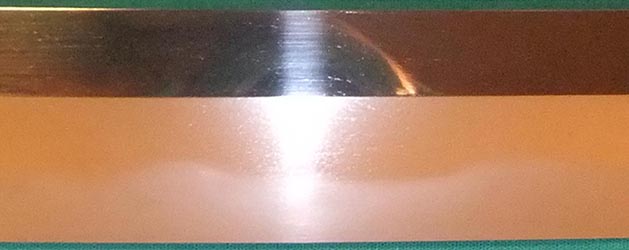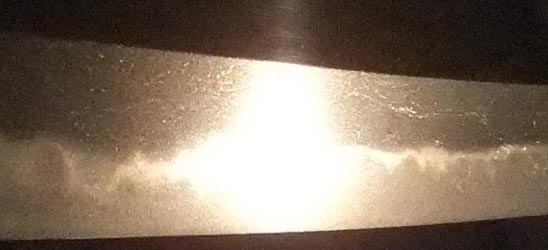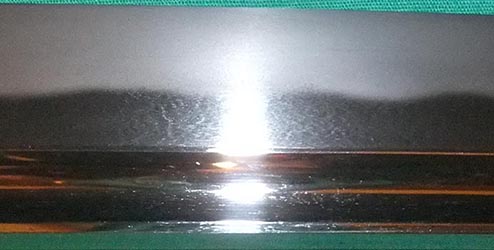We have received questions regarding treatment with uchiko powder. Those are "is it necessary?", "is it good for blade?", "doesn't it destroy the polishing?", and etc.
Then, our smith kokaji tried to explain a little bit about it to clear the issue.
At first, I can say treatment with uchiko is very necessary to see the quality of sword.
On the classical style polishing (sashikomi polishing), years of treatment with uchiko can clean the blade surface. Of course, it must be done tenderly and carefully not to make scratches. During months or years of treatment the blade surface becoming clearer, and delicate activities coming up. Especially activities in ji, like utsuri, comes up, and you could find other activities what you didn't see when it was polished up. Uchiko is a fine powder of polishing stone, mainly "uchigumori" stone. So the long time treatment with it means a soft polishing with oil, fine stone powder and cloth. Some of those blades with long time treatment have really amazing appearance what can't get by fresh polishing. However it can bring up the flaws in the blade as well. There is no perfect sword. Any masterpieces also have flaws somewhat. So the uchiko treatment bring up real face of sword. You should love the sword as it is including flaws.
You can find many of those examples in the Tokugawa Art Museum in Nagoya city. The swords there keep the old polishing from the Edo period. (To be honest, we don't know how old the polishings are.) And you can see what is traditional polishing in Samurai age, and what is good sword.
Tokugawa Museum => Collection Highlights | Tokugawa Art Museum (tokugawa-art-museum.jp)
Sample of Sashikomi style polishing (Ichimonji Sukezane with fresh polishing)
Another sample of Sashikomi style polishing (Osafune Sukenaga with many years uchiko and oil treatment)
On the other hand, what about the modern style polishing (hadori polishing). When I was young, about 50 years ago, I learned that hadori work must be done soft not to make a clear border against the ji. If you can make such a soft hadori, it could perish and blend with real hamon after long time treatment. Of course, the hadori work was the way to help weak hamon at the time. So, such a soft hadori was necessary. Because hadori work was an obstruction to see the blade anyway.
But recently, the meaning of hadori work has changed. It is a kind of make-up. It is not a beauty of the blade itself, but another beauty added by the polisher. So the hadori work is done very strongly to make a big contrast between white hadori and black shining steel. So the modern style polishing is a cosmetic. Therefore some people call the hadori style polishing "Kesho togi". (kesho means cosmetic in Japanese) You don't need to see real face of the blade, but you should last the plastic beauty long. In such a case, you don't need to use uchiko powder. Any soft treatment with uchiko powder can destroy the excellent cosmetic. You should use micro fiber cloth to remove oil on the blade.
Sammple of Hadori style polishing (Ichimonji Yoshihira with soft hadori)


Another sample of Hadori style polishing (Nagasone Okimasa with strong hadori)


So the point is what you want to see in the blade. If you want to see the blade quality, in other words, the beauty of the sword, you should use uchiko powder to clean up the blade surface. If you want to keep the beautiful looking of the aesthetical polishing, you don't need to use uchiko powder.
Of course, I recommend the classical style polishing (sashikomi style) and treatment with uchiko powder. Because I want to see the real face of sword. I believe it is the beauty of sword, even if it has some flaws.
=> Polishing styles, Hadori style and Sashikomi style